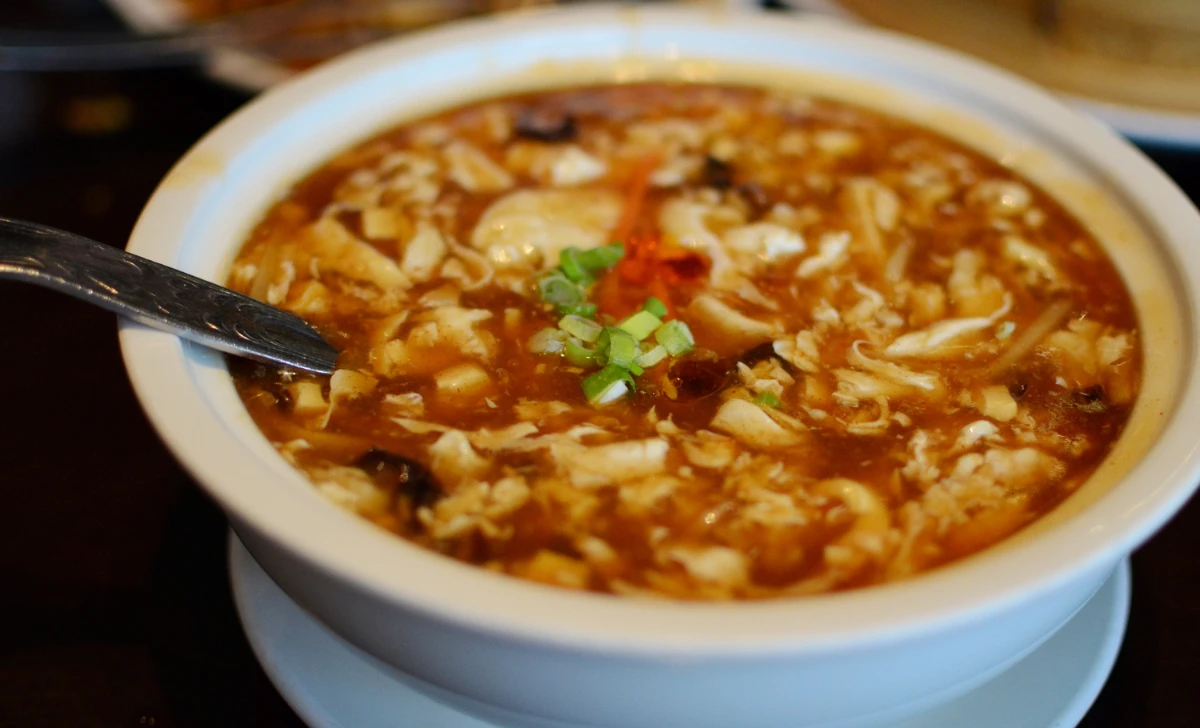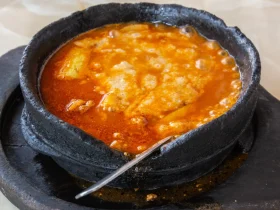When the weather outside turns chilly and you’re craving something to warm both your body and soul, there’s nothing quite like a steaming bowl of hot and sour soup. This classic Asian dish has the perfect balance of flavors, combining the heat of spices with the tanginess of vinegar. Whether you’re a seasoned home cook or just starting your culinary journey, this hot and sour soup recipe will guide you through creating a bowl of comfort with a delightful kick.
[ez-toc]
History
In the world of culinary delights, few dishes can boast a history as rich and diverse as that of hot and sour soup. This iconic Asian creation, known for its perfect fusion of fiery heat and tangy sourness, has a journey that spans centuries and cultures. Let’s take a stroll through time to uncover the captivating evolution of this beloved soup.
Ancient Roots and Culinary Crossroads
The origins of hot and sour soup can be traced back to ancient China, where it was born from a melting pot of flavors and traditions. In the Tang Dynasty (618-907 AD), chefs began experimenting with ingredients like vinegar and spices, aiming to balance the yin and yang of flavors. This experimentation gave rise to the initial versions of what we now know as hot and sour soup.
A Culinary Tapestry of Regions
As trade routes expanded and cultures intermingled, the recipe for hot and sour soup embarked on a journey of its own. Travelling along the Silk Road, this delightful dish encountered a myriad of influences from different regions. In Japan, the soup took on a lighter, more delicate profile, while in Thailand, the addition of lemongrass and galangal infused it with a unique Southeast Asian twist.
Migration and Fusion
With Chinese migration to various parts of the world, hot and sour soup transcended cultural boundaries and found its way onto international menus. Chinese immigrants in the United States introduced the dish to the Western palate, where it underwent further transformation. Chefs adapted the recipe to suit local tastes, resulting in variations that ranged from milder to more intense, catering to a wide spectrum of preferences.
Modern Innovations and Culinary Creativity
As culinary arts evolved and fusion cuisine gained popularity, hot and sour soup saw a resurgence in creativity. Chefs began experimenting with unconventional ingredients, elevating the dish to new heights. From the infusion of exotic spices to the incorporation of diverse proteins, the possibilities became endless, and each interpretation was a testament to the ever-evolving nature of this classic.
A Global Favorite with a Personal Touch
In the digital age, the sharing of recipes and culinary experiences has propelled hot and sour soup into the homes of cooks and food enthusiasts worldwide. With each recipe passed down through generations and every tweak made to suit individual tastes, the soup has become a canvas for personal expression. Cooks add their unique flair, adapting the heat and sourness to their liking, resulting in a global symphony of flavors.
Preserving Tradition in the Modern Era
Amidst the constant evolution, there remains a deep respect for the traditional roots of hot and sour soup. Authenticity is still celebrated, and many cooks endeavor to recreate the original flavors that emerged in ancient China. In culinary schools and cooking classes, budding chefs are taught the techniques and intricacies of the traditional recipe, ensuring that the essence of hot and sour soup is preserved for generations to come.
A Flavorful Conclusion
From its humble beginnings in ancient China to its present-day status as a beloved global dish, hot and sour soup has truly undergone a remarkable transformation. It has woven itself into the tapestry of culinary history, adapting, fusing, and embracing the cultural influences it encountered along the way. With every spoonful, we savor not only its delectable taste but also the stories of generations past and the vibrant cultures that have contributed to its evolution.
Time
| Cooking Step | Preparation Time |
|---|---|
| Gather Ingredients | 10 minutes |
| Prepare Broth and Aromatics | 15 minutes |
| Infuse Spices | 5 minutes |
| Prepare Main Ingredients | 20 minutes |
| Balance Heat and Sourness | 10 minutes |
| Thicken the Soup | 10 minutes |
| Add Silken Egg Ribbons | 5 minutes |
| Garnish and Final Touches | 5 minutes |
| Serve and Savor | – |
| Total Preparation Time | 80 minutes |
Please note that the total preparation time of 80 minutes is an estimate and may vary based on individual cooking skills and kitchen efficiency. Enjoy the journey of creating your hot and sour soup!
Ingredients
| Ingredients | Quantity |
|---|---|
| Chicken or Vegetable Broth | 2 cups |
| Mushrooms (shiitake or wood ear) | 1/2 cup, sliced |
| Tofu | 1/4 cup, cubed |
| Bamboo Shoots | 1/4 cup, sliced |
| Red Chili Pepper | 1, thinly sliced |
| Ginger | 1 teaspoon, minced |
| Garlic | 1 clove, minced |
| Soy Sauce | 1 tablespoon |
| Rice Vinegar | 2 tablespoons |
| White Pepper | 1/4 teaspoon |
| Cornstarch | 1 tablespoon |
| Eggs | 1, beaten |
| Green Onions | 2 stalks, chopped |
| Sesame Oil | 1 teaspoon |
Please adjust the quantities according to your preferences and enjoy your delicious hot and sour soup for two!
Directions
Step 1: Gather Ingredients
Before you dive into the culinary magic, gather all the ingredients to ensure a smooth cooking experience. Having everything ready will make the process more enjoyable.
Step 2: Prepare Broth and Aromatics
- In a pot, bring the chicken or vegetable broth to a gentle simmer.
- Add the sliced mushrooms and bamboo shoots to infuse their flavors into the broth.
- Sauté the minced ginger and garlic in a separate pan until fragrant, then add them to the broth mixture.
Step 3: Infuse Spices
- Introduce the thinly sliced red chili pepper to the broth for a touch of heat.
- Sprinkle the white pepper into the broth to add a subtle kick.
Step 4: Prepare Main Ingredients
- Gently add the cubed tofu to the simmering broth, allowing it to soak up the flavors.
- Let the orchestra of ingredients mingle as you stir in the sliced mushrooms and bamboo shoots.
Step 5: Balance Heat and Sourness
- Adjust the heat level by adding more or less red chili pepper, according to your preference.
- Create the perfect tanginess by pouring in the rice vinegar.
- Introduce the umami undertone with a drizzle of soy sauce.
Step 6: Thicken the Soup
- Create a cornstarch slurry by mixing the cornstarch with a small amount of water until smooth.
- Gently pour the slurry into the soup, stirring constantly until the soup thickens to your desired consistency.
Step 7: Add Silken Egg Ribbons
- Slowly drizzle the beaten egg into the soup while stirring gently. The egg will create delicate ribbons.
- Allow the egg to cook for a minute, contributing to the soup’s luxurious texture.
Step 8: Garnish and Final Touches
- Sprinkle the chopped green onions over the soup, adding a burst of color and freshness.
- Finish with a drizzle of sesame oil for an aromatic flourish.
Step 9: Serve and Savor
Ladle the hot and sour soup into bowls, marveling at the harmonious blend of flavors. Allow the steam to embrace you as you take your first spoonful, savoring the symphony of heat, tanginess, and umami.
Congratulations! You’ve successfully crafted a bowl of hot and sour soup that’s not only a delight to the taste buds but also a testament to your culinary prowess.
Equipment Required
Nutrition Information
| Nutrition Information | Per Serving |
|---|---|
| Serving Size | 1 bowl (about 2 cups) |
| Calories | 150 kcal |
| Total Fat | 6g |
| – Saturated Fat | 1g |
| Cholesterol | 40mg |
| Sodium | 800mg |
| Total Carbohydrates | 15g |
| – Dietary Fiber | 2g |
| – Sugars | 3g |
| Protein | 10g |
Please note that these values are approximate and can vary based on the specific ingredients used and portion sizes. Always refer to the nutritional labels on the ingredients for the most accurate information.
Tips
- Mellowing the Heat: If you’re sensitive to spice, remove the seeds from the chili pepper before slicing. This way, you’ll get the flavor without the intense heat.
- Tofu Texture: To achieve a firmer texture, consider pressing the tofu between paper towels before cubing it. This removes excess moisture and allows it to absorb more flavors.
- Balancing Sourness: Adjust the amount of rice vinegar to strike the perfect balance between sour and tangy. Start with less and gradually add more to suit your taste.
- Perfectly Silken Egg Ribbons: Slowly pour the beaten egg into the soup while stirring gently and consistently. This technique ensures those beautiful silken ribbons.
- Garnish with Finesse: When garnishing with green onions and sesame oil, remember that a little goes a long way. These accents add freshness and fragrance without overpowering the soup.
Pros & Cons
| Pros | Cons |
|---|---|
| ✅ Balanced flavors of heat and tanginess | ❌ May be too spicy for sensitive palates |
| ✅ Rich in protein from tofu and eggs | ❌ Requires preparation of multiple ingredients |
| ✅ Low in calories and fat | ❌ Cornstarch thickening may alter texture |
| ✅ Customizable with various ingredients | ❌ Some ingredients may not be readily available |
| ✅ Offers a comforting and warming experience | ❌ Simmering time may be longer for busy schedules |
Conclusion
As we draw the culinary curtain on this hot and sour soup recipe, we invite you to take a leap into a world of delightful contrasts. A world where fiery heat and tangy sourness come together in perfect harmony, creating a symphony of flavors that dances on your taste buds. This recipe isn’t just about ingredients and techniques; it’s about the experience of crafting a bowl of comfort that warms your soul and ignites your senses.
With every chop of vegetables, every swirl of beaten egg, and every careful balance of spices, you’re creating a masterpiece that’s uniquely yours. Whether you’re seeking solace on a chilly day or simply craving an unforgettable culinary adventure, this hot and sour soup is your ticket to an enchanting journey through taste and tradition.
So, don that apron, embrace the joy of discovery, and let your kitchen become a canvas for your culinary expression. As you savor the first spoonful, remember that you’ve embarked on more than just a cooking endeavor; you’ve embarked on a journey that connects you to cultures, flavors, and the simple pleasure of a steaming bowl of soup.
Embrace the heat, celebrate the sourness, and relish the experience. Your taste buds will thank you, your senses will dance, and your heart will warm as you indulge in the rich and rewarding world of hot and sour soup. Don’t just read about it; let your taste buds tango with this bowl of comfort and excitement. It’s time to ladle up, sip away, and savor the symphony of flavors that await in each spoonful. Your culinary adventure begins now.
Facts
- Fact 1: 🌶️ Heat with a History
- Did you know that the use of chili peppers in hot and sour soup isn’t just for flavor? These little fireballs were added centuries ago as a natural remedy for colds! So, next time you’re sipping this spicy potion, remember, you’re not just warming your taste buds; you’re giving your immune system a little boost too.
- Fact 2: 🍳 Egg-cellent Symphony
- The art of adding beaten eggs to hot and sour soup isn’t just about flavor; it’s about texture and aesthetics. The silky ribbons of egg create a visual masterpiece that’s not only pleasing to the eye but also a joy to taste. It’s like a culinary ballet performance right in your bowl!
- Fact 3: 🌍 A Soup of Many Cultures
- Hot and sour soup’s journey isn’t confined to China alone. As it traveled along the Silk Road, it absorbed influences from various cultures. From Southeast Asian tanginess to Japanese delicacy, each variation tells a tale of cross-cultural culinary exchange. It’s not just soup; it’s a history lesson in a bowl!
- Fact 4: 🧐 The Myth of Tofu Origins
- Tofu, a key ingredient in hot and sour soup, has a mysterious origin. Legend has it that tofu was discovered by accident when a Chinese cook mixed soy milk with sea salt. The result? A versatile ingredient that brings creaminess to your soup and keeps the mystery alive!
- Fact 5: 🎨 Your Soup, Your Canvas
- Hot and sour soup isn’t just a recipe; it’s a masterpiece waiting for your artistic touch. Don’t like mushrooms? Swap them for your favorite veggies. Feeling adventurous? Add a dash of lemongrass. This soup is your blank canvas, and your kitchen is the studio. Get creative and let your taste buds be the critics!
FAQ’s
Can I make this soup less spicy?
Absolutely! Adjust the amount of red chili pepper to your preference or omit it entirely for a milder version.
Can I use vegetable broth instead of chicken broth?
Yes, you can definitely use vegetable broth for a vegetarian version of the soup. It will still be flavorful and delicious.
Can I substitute rice vinegar with other types of vinegar?
While rice vinegar is traditional, you can experiment with white vinegar or apple cider vinegar. Keep in mind that the flavor profile may vary slightly.
Is there a gluten-free option for thickening the soup?
Yes, you can use cornstarch, which is gluten-free, to thicken the soup. Make sure to choose a certified gluten-free cornstarch.
Can I freeze leftover hot and sour soup?
Yes, you can freeze the soup for later consumption. However, note that the texture of tofu might change upon freezing. Consume it within a month for the best quality.
Can I use pre-packaged sliced mushrooms?
Absolutely! Pre-packaged sliced mushrooms are a convenient option and can be used in the soup without any issues.
How do I prevent the egg ribbons from clumping together?
Slowly pour the beaten egg into the soup while stirring gently and consistently. This technique ensures that the egg forms delicate, separate ribbons.
What are some alternative protein sources besides tofu?
You can use cooked chicken, shrimp, or even seitan as protein alternatives. Just adjust cooking times accordingly.
Can I prepare the soup in advance and reheat it?
Yes, you can prepare the soup in advance and reheat it gently on the stove. Add a splash of water or broth to maintain the desired consistency.
Can I add noodles to the soup for a heartier meal?
Absolutely! Adding cooked rice noodles or vermicelli just before serving can transform the soup into a satisfying and complete meal.












Leave a Review